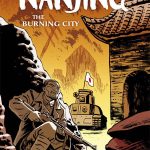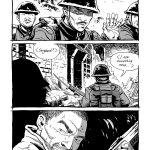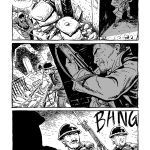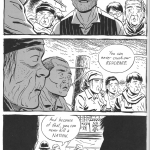Review: Nanjing: the Burning City, by Ethan
Young
Part of my goal this Winter was to read books published in
2015 as a way to understand the publishing year. I’ve been slowly accomplishing
this goal, and a recent read has been Ethan Young’s Nanjing: the Burning City, published in hardcover by Dark Horse. In
this 214 page black and white graphic novel, Young follows two Chinese soldiers
on the run from the conquering Japanese army during the Nanjing Massacre (also
known as the Rape of Nanjing).
It seems as though part of Young’s goal in Nanjing: the Burning City is to show
this part of the Second Sino-Japanese war with as little nationalism as
possible; while a majority of the invading Japanese soldiers are depicted as
violent, cruel, disgusting pigs, some are not. Likewise, Lu and the Captain,
the protagonists of the comic, are at best morally ambiguous characters, both
of whom do things that are abhorrent in their own ways. Even the leaders of the
Chinese army get their share of the blame for the events of the Nanjing
Massacre. Young’s characters cycle between being ciphers and overly earnest,
and much of the timing seems shifted towards the end of the narrative – the best written character, Yan, a woman
protecting her family from the invading Japanese, shows up halfway through the
book.
Pulling the whole
thing together is Young’s accomplished illustration; each page is set up in a
1×3 grid with variations, and Young has chosen a pace that draws the reader
into the sprinting, shooting, and creeping of characters trying to find the
best way to stay alive. Young’s inking is textured and heavy, and delivers a
sense of both deep fear and faltering exhaustion.
Young doesn’t truly
address the horrors of the Nanjing Massacre head on, especially with regards to
the violence that occurred against women and children. The most
unsettling parts of Nanjing: the Burning City happen
off-panel, with the main characters in hiding or waiting to ambush unsuspecting
Japanese soldiers. Young does show readers a small piece of the aftermath of
the Japanese army’s war crimes, and certainly the book certainly isn’t
easy to read. Young’s characters go through a hellscape to find safety, to
varying degrees of success.
In some ways, I think Nanjing:
the Burning City is successful because it avoids being overly didactic.
Follow these two soldiers and hope for their survival, it seems to say, and
worry about everything else later. The events that are going on around the
Captain, Lu, and the people they meet, act as a primer for further research and
reading, if any reader is so inclined. That said, I’ve seen many stories about
the plight of soldiers during wartime, and this comic is a retreading of those
old tropes. I think Nanjing: the Burning
City might have been a more effective story had it been told from the
perspective of Young’s best character, Yan. Still, as a well-illustrated comic
focused on the terror and destruction of war, Nanjing: the Burning City is a strong introduction to Ethan Young’s
work.




